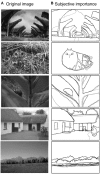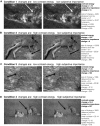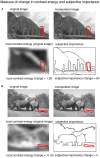Change Blindness Is Influenced by Both Contrast Energy and Subjective Importance within Local Regions of the Image
- PMID: 29046655
- PMCID: PMC5632668
- DOI: 10.3389/fpsyg.2017.01718
Change Blindness Is Influenced by Both Contrast Energy and Subjective Importance within Local Regions of the Image
Abstract
Our visual system receives an enormous amount of information, but not all information is retained. This is exemplified by the fact that subjects fail to detect large changes in a visual scene, i.e., change-blindness. Current theories propose that our ability to detect these changes is influenced by the gist or interpretation of an image. On the other hand, stimulus-driven image features such as contrast energy dominate the representation in early visual cortex (De Valois and De Valois, 1988; Boynton et al., 1999; Olman et al., 2004; Mante and Carandini, 2005; Dumoulin et al., 2008). Here we investigated whether contrast energy contributes to our ability to detect changes within a visual scene. We compared the ability to detect changes in contrast energy together with changes to a measure of the interpretation of an image. We used subjective important aspects of the image as a measure of the interpretation of an image. We measured reaction times while manipulating the contrast energy and subjective important properties using the change blindness paradigm. Our results suggest that our ability to detect changes in a visual scene is not only influenced by the subjective importance, but also by contrast energy. Also, we find that contrast energy and subjective importance interact. We speculate that contrast energy and subjective important properties are not independently represented in the visual system. Thus, our results suggest that the information that is retained of a visual scene is both influenced by stimulus-driven information as well as the interpretation of a scene.
Keywords: change detection; contrast energy; natural images; scene perception; subjective importance.
Figures






References
-
- De Valois R. L., De Valois K. K. (1988). Spatial Vision. Oxford: Oxford University Press.
LinkOut - more resources
Full Text Sources
Other Literature Sources

